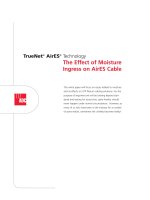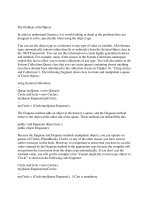Tài liệu The Effect of Moisture docx
Bạn đang xem bản rút gọn của tài liệu. Xem và tải ngay bản đầy đủ của tài liệu tại đây (287.09 KB, 8 trang )
This white paper will focus on issues related to moisture
and its effects on UTP Plenum cabling solutions. For the
purpose of argument we will be looking beyond stan-
dards and testing for issues that, quite frankly, should
never happen under normal circumstances. However, as
many of us who have been in the industry for a number
of years realize, sometimes the unlikely becomes reality!
TrueNet
®
AirES
®
Technology
The Effect of Moisture
Ingress on AirES Cable
TrueNet
®
AirES
®
Technology: The Effect of Moisture Ingress on AirES Cable
Page 2
The industry bodies have this to say about wet and dry
locations:
BICSI TDM manual, 9th edition, Chapter 4 – Horizontal
Distribution Systems, Section 1 – Horizontal Pathway
Systems, final paragraph of page 4-5, which states:
Wet Locations
Intrabuilding horizontal pathways shall be installed in
“dry” locations that protect cables from moisture levels
that are beyond the intended operating range of
“inside” premises cables. For example, slab-on-grade
construction where pathways are installed underground
or in concrete slabs that are in direct contact with soil
(e.g., sand, gravel, etc.) are considered to be “wet loca-
tions.” In the United States, see the NEC, Article 100,
for definitions of damp, dry and wet locations.
NEC Article 100 – Definitions
Locations:
Damp locations:
Partially protected locations under
canopies, marquees, roofed open porches, and like
locations, and interior locations subject to moderate
degrees of moisture, such as some basements, some
barns, and some cold-storage warehouses.
Dr
y Locations: A location not normally subject to damp-
ness or wetness. A location classified as dry may be
temporarily subject to dampness or wetness, as in the
case of a building under construction.
W
et Locations: Installations underground or in concrete
slabs or masonry in direct contact with the earth or
other liquids, such as vehicle washing areas, and loca-
tions exposed to weather and unprotected.
The above being said, let’s have some fun.
The AirES cabling innovation incorporates air pockets
around the primary conductor. They run the entire
length of the cable (a bit like rifling). These air pockets
allow AirES to achieve unparalleled electrical per-
formance to overall size. This performance is achieved
through mixing the dielectric constant of Air and FEP
together to make an overall dielectric constant better
than that of FEP alone (for more information please see
our “Electrical Attributes” white paper on this subject).
It is worth noting the dielectric constant of water is ter-
rible when compared with most insulation materials.
Additionally, as many people know, mixing amperage
with water is never a good idea. For this reason BICSI
and the NEC have mandated that UTP cabling be
placed in “dry” locations.
However we have decided to test how AirES would per-
form in a “wet” environment. Because of ADC’s ingen-
ious use of air pockets to improve electrical perform-
ance, a query has arisen with regards to moisture travel-
ing down the air channels themselves.
To put this issue to the test, we submerged a sample of
AirES cable in a water solution with a dye tracer. For
the test we needed a control sample as well and used a
competitors cable with solid FEP insulation over the
copper conductor. As in the image below, both cables
were cut to the same length. The same amount of solu-
tion (5ml) was used for each.
We then placed both samples (Green AirES and White
Competitor) into the solution for a period of 2 hours. It’s
worth noting that the fluid level in the AirES graduated
cylinder with the cable sample was at 5.95ml. The com-
petitor sample fluid level was at 6.1ml. This can be attrib-
uted to reduced displacement of fluid with AirES,
because of the smaller outer diameter/cross sectional
area of the cable.
TrueNet
®
AirES
®
Technology: The Effect of Moisture Ingress on AirES Cable
Page 3
After soaking in the solution for 2 hours the cables
were removed and the fluid levels were measured to
determine how much had soaked into each cable.
The competitor sample soaked in 0.15ml of fluid. AirES
soaked in 0.05ml of fluid.
The reason for the fluid absorption difference was obvi-
ous once both samples were cut open. In order to
achieve Cat. 6 performance a “star” filler has been
used on the competitor cable to separate the pairs
(which makes the cable larger). This allows for more
“free space” within the cable. Therefore, more fluid to
be absorbed. The AirES cable, by introducing air
between the copper conductor and the insulation, has
less need for pair separation. This allows for the smaller
cable size and less absorption.
The conductors were then inspected to see how much of
the solution was absorbed by the conductors themselves.
Above are all 4 pairs of the competitor sample. It would
be fair to say that none of the solution absorbed was
attributed to the conductors themselves. No penetra-
tion was evident.
Even though the amount of fluid absorbed by the AirES
cable was less, fluid did penetrate the air pockets within
the insulation due to capillary action. It flowed up to
the level of the fluid within the cylinder.
This is most evident in the orange and green pairs,
white conductor, with a color change to blue where the
dye has penetrated.
Although a fascinating result, it is actually quite mean-
ingless in a real life installation. This did, however, prove
that the air pockets do exist.
TrueNet
®
AirES
®
Technology: The Effect of Moisture Ingress on AirES Cable
Page 4
We then tested the cable as it is installed e.g. with a
jack attached. A little bit of history about ADC connec-
tivity first. One of our claims has been the 45° IDC.
With the use of this technology, ADC has been able to
achieve a gas tight seal around the contact and in
doing so sealed the cabling conductor to that contact.
In the example above, ribs (arrow 1) on either side of
the connection point squeeze (hold) the insulation to
take any disturbance through movement of the cable
away from the contact itself. These ribs also help to seal
the insulation around the conductor. The IDC, or
Insulation Displacement Contact, does just that. It dis-
places the FEP insulation around the connection point,
which completely seals the junction from gas and/or
water ingress.
To simulate what might happen if an ADC jack with
AirES cable were to be subjected to direct contact with
water we submerged a terminated jack into the same
water/dye tracer liquid as the first test. In this test we
let the cable soak for 14 hours. This was 7 times longer
than the first test.
The results were astounding. We rinsed the excess dye
tracer off of the jack after removal from the liquid (as in
the first test conductors). As you can see below, the
label to the jack wiring scheme was completely tinted
blue from soaking. None of the tracer was evident
on any of the pairs. The 45° IDC contacts had com-
pletely stopped any penetration whatsoever.
TrueNet
®
AirES
®
Technology: The Effect of Moisture Ingress on AirES Cable
Page 5
For the next part of our investigation we subjected
AirES cable to a harsh humid environment and meas-
ured the effects. To understand the effects, we used an
industry standard construction Cat. 6 cable with a star
filler as a control.
For the purpose of extreme conditions 70°C (158°F) at
95% rH were selected as the temperature and humidity.
The cables were placed into the environmental chamber
for a period of 5 days. Testing was conducted before
the samples were placed in the chamber and one-hour
after completion. The results were then compared to
show any effect the moist heat may have had on the
electrical integrity.









